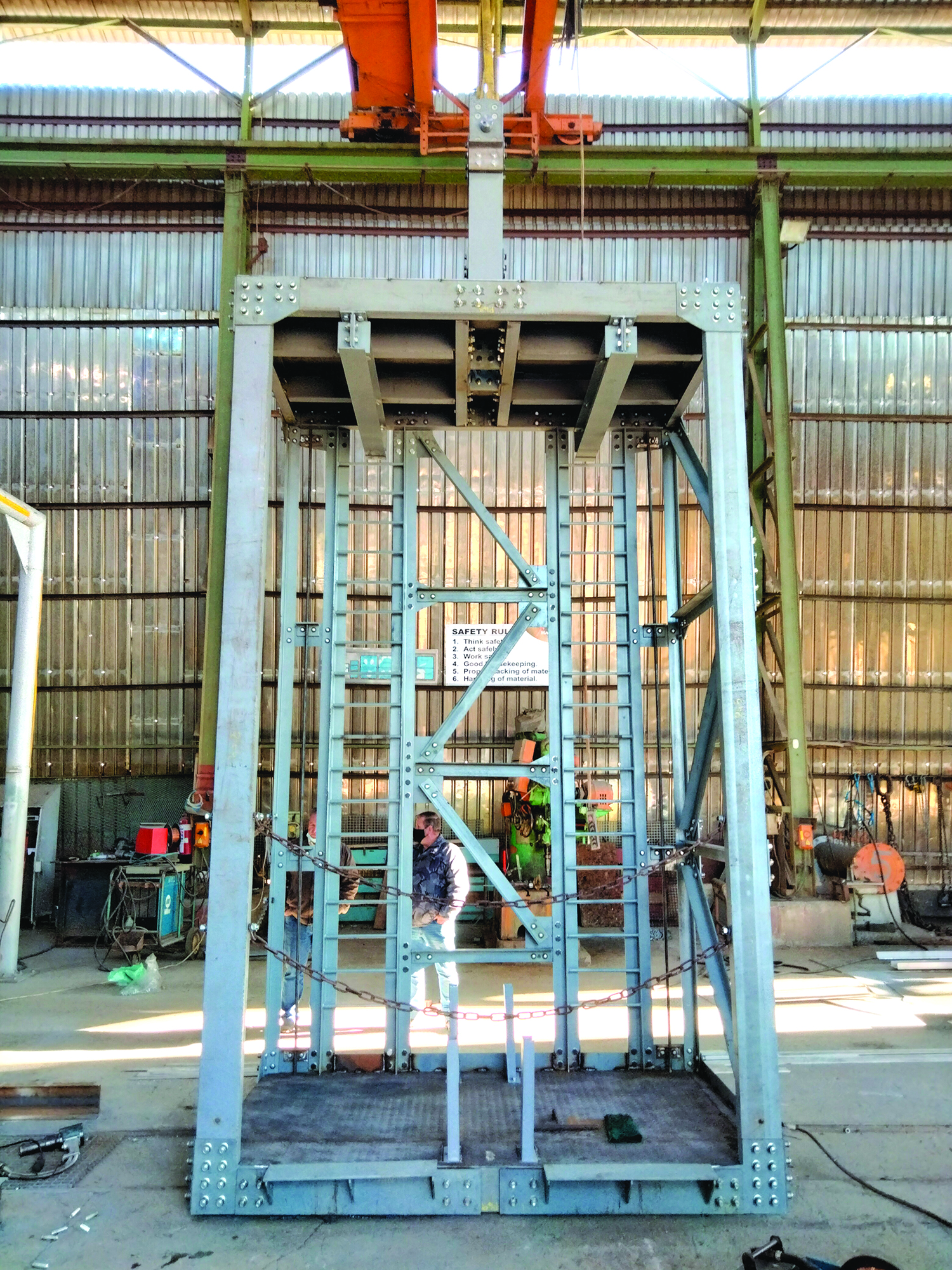
The contractor designs and fabricates a skeleton cage, shown here, that was attached below the shaft’s skip and could hold workers and equipment needed to remove a brattice wall as part of the mine’s ventilation upgrade project.
United Mining Services (UMS) recently provided a fast, innovative solution for Harmony Gold’s Target 1 gold mine to optimize shaft cooling capability.
The Target 1 mine, located in the Free State province of South Africa, produced 2,244 kilograms (2.47 tons) of gold in 2020. The mine uses the shaft to transport men, material and rock from surface to 203 level, at a depth of 1,800 meters (m) or 5,900 ft. A single decline, equipped with a conveyor belt, connects the 203 level to the 255 level, approximately 2,050 m (6,700 ft) below surface.
Prospecting at the mine location dates back to 1890 and the shaft was constructed in the mid-1940s. Consequently, there are no design documents available for the shaft, making modifications challenging. UMS was tasked by the mine to come up with a solution to remove the brattice wall, and enable conversion of an upcast shaft compartment to downcast to facilitate more cool air entering the shaft from a newly built refrigeration plant at the surface.
Takalani Randima, managing director of UMS Mining Engineering Technical Services (METS), explained that the rectangular shaft has seven compartments, six of which were used for downcast air flow. In order to convert the seventh compartment to downcast and allow cool air from the new refrigeration plant to pass down through the entire shaft, a portion of the brattice wall in the shaft had to be cut from the surface down to 9 m below.
After assessing the shaft, UMS determined there were water and electricity service cables in the way in the brattice wall section. “To access the shaft wall safely without causing damage to the service cables, we designed a ‘skeleton’ that could be attached beneath the skip compartment of the shaft, similar to a cage,” said Len Phillipson, contracts manager at UMS.
Phillipson said UMS METS designed the skeleton to fit the width of the entire shaft, with the capacity to carry up to five people and equipment to a maximum weight of 8 metric tons. The skeleton was constructed by Harmony’s skip and conveyance workshop, and UMS Shaft Sinkers executed the project. Phillipson said the mine will be able to use the skeleton for other work that needs to be undertaken on the shaft.
Cutting the wall also proved to be a challenge as it was very old and had no reinforced steel. “During core drilling to check the capacity, we saw that the wall was already cracking. To prevent the wall from falling down, which could have caused irreparable damage to the shaft, we proposed to strap it with steel, and cut it in three sections, each measuring 3 m long by 2.8 m wide.
“As there were no drawings of the shaft, we were essentially going in blind, and relied on experience to remove the wall safely,” Phillipson said. “Considering that each wall section weighed approximately 1.6 tons, cutting and removing them was not without its risks, but these risks were effectively mitigated and we are pleased to have completed this complex task safely and successfully.”
“Our initial time frame to complete the project was 30 days, but with collaboration between the customer, UMS METS and UMS Shaft Sinkers to solve the challenge, we were able to fast-track it in 19 days,” Randima said.
Phillipson noted that owing to the collaboration between UMS and the mine team, the mine did not have to stop production while the work was carried out on the shaft. Following the modification, the mine was able to significantly increase the amount of cold air entering the shaft, allowing underground workers to stay much cooler and safer.









